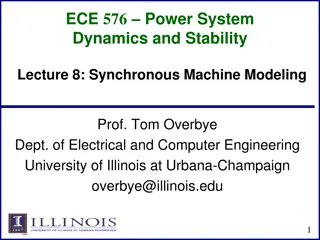
Analysis of OPA569 Bridge-Tied-Load Circuit and IMONITOR Pin Limitations
Explore the evaluation of the OPA569 Bridge-Tied-Load circuit by Errol Leon and Thomas Kuehl, focusing on the utilization of IMONITOR pin as feedback, simulation results with different resistor values, and overcoming IMONITOR pin limitations with traditional voltage feedback configurations.
Download Presentation

Please find below an Image/Link to download the presentation.
The content on the website is provided AS IS for your information and personal use only. It may not be sold, licensed, or shared on other websites without obtaining consent from the author. If you encounter any issues during the download, it is possible that the publisher has removed the file from their server.
You are allowed to download the files provided on this website for personal or commercial use, subject to the condition that they are used lawfully. All files are the property of their respective owners.
The content on the website is provided AS IS for your information and personal use only. It may not be sold, licensed, or shared on other websites without obtaining consent from the author.
E N D
Presentation Transcript
Evaluation of OPA569 Bridge-Tied-Load Errol Leon and Thomas Kuehl Precision Linear Analog Applications February 3, 2016 1
OPA569 bridge-tied-load analysis outline 1) Simulation with Rset of 2.5k and Rload of 10 2) I-monitor pin limit as feedback 3) TINA-TI model verification with traditional feedback in place of IMONITOR with an Rload of 10 4) Test set-up of customer s circuit with traditional feedback with an Rload of 9.9 5) Test set-up of customer s circuit with traditional feedback with an Rload of 10.2 6) Summary of analysis and recommendation 2
TINA-TI schematic of customer circuit with Rset 2.5k and Rload 10 4
TINA-TI simulation of customer circuit with Rset 2.5k and Rload 10 Note that even though the simulation doesn t show the I-flag condition, the actual circuit does due to the IMONITOR limit 5
Analysis of I-monitor pin limitations of OPA569 Even with Rset at 2.5k , the limit of the IMONITOR pin still causes the I-flag condition. From page 13 in the current monitor section of the data states: Additionally, the swing on the IMONITOR pin is smaller than the output swing. When the amplifier is sourcing current, the voltage of the Current Monitor pin must be two hundred millivolts less than the output voltage of the amplifier. Conversely, when the amplifier is sinking current, the voltage of the Current Monitor pin must be at least two hundred millivolts greater than the output voltage of the amplifier. When condition is violated the current is no longer a linear representation of 1:475 Iload. To overcome the IMONITOR pin limit, a traditional voltage feedback configuration using a 2.5k resistor was tested. 7
Simulation using traditional voltage feedback with Rset and Rf at 2.5k , and Rload at 10 8
TINA-TI schematic of customer circuit with Rset and Rf are 2.5k and Rload is 10 using traditional voltage feedback 9
TINA-TI simulation of customer circuit with Rset and Rf are 2.5k and Rload 10 using traditional voltage feedback Note symmetry of Iload 10
Test setup of customer circuit with PCB REF5020 voltage regulator was used to generate a Vref of 2V. Rload is 10 , Rcl1 and Rcl2 are 14k , Rset is 2.5k . Feedback resistor is 2.5k . Feedback resistor REF5020 11
Observed current limit flag pin and I-load in traditional feedback configuration with an Rload of 9.9 Current limit flag does not trigger below specified limit and no clipping occurs Vin Vload + Vload - Current Limit Flag 12
Observed current limit flag pin and I-load in traditional feedback configuration with an Rload of 10.2 Current limit flag does not trigger below specified limit and no clipping occurs Vin Vload + Vload - Current Limit Flag 13
Summary of analysis and recommendation IMONITOR must be 200mV from supply as specified on page 13 of datasheet. If violated, IMONITOR no longer holds a linear relationship with Iload. This can cause the flag to trigger early and may cause the output to latch at a supply rail. The output is clamping when Vin approaches 0V in the customer s application circuit. This is due to exceeding the OPA569 output swing limit described on page 3 of the datasheet. Modifying the application circuit to use a traditional voltage feedback configuration resolves the issue encountered when the IMONITOR swing limit is exceeded. It is recommended for the intended input voltage range that a traditional voltage feedback configuration be used in place of the IMONITOR configuration. A feedback resistor value of 2.5k was used for the verification. 14






















